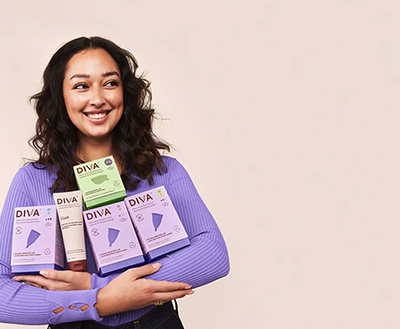
In this article /

After being diagnosed with endometriosis, I tried to limit my exposure to endocrine disruptors. Effects of endocrine disruptors on the human body include the breakdown of communication of our nervous system, as well as the hormonal system.
With a hormonal disorder like endometriosis, I knew that limiting my exposure to these hormone disrupting chemicals would help manage my diagnosis but would also mean changing a lot about my already altered life. And if I’m being honest, it was exhausting.
Switching my disposable menstrual products to the DIVA Cup was great—if you’re looking to reduce your exposure, this is an incredible first step! But finding an alternative for literally every other thing that my body encountered? Not so easy. From the products you use in the shower, to food storage containers, to the very clothes you wear, these endocrine disrupting chemicals are everywhere.
What are Endocrine Disruptors?
Termed xenoestrogens, these toxic chemicals break down communication between glands and natural hormones in your body. Endocrine disrupting chemicals (or EDCs) interfere with the system responsible for regulating the release of hormones. Your endocrine system also controls functions like:
- Mood and energy (regulated by hormones; cortisol, melatonin and adrenaline)
- Reproduction (estrogen and testosterone), and
- Metabolism (insulin and thyroid)
Sometimes endocrine disruptors mimic hormones and tell the body to do the wrong thing or block it from doing what it needs to do. Exposure can happen through our diet, skin, air and drinking water. Because the endocrine system changes with even slight increases in hormones, even small amounts of exposure can impact someone’s health.
Once released, endocrine disruptors don’t go away. Long-term exposure can worsen or cause several health issues including reproductive disorders (PCOS and endometriosis), breast cancer, diabetes, and behavioral challenges in children.
Common Endocrine Disruptors
Bisphenol A (BPA): Chemical compound used in the manufacturing of various plastics like plastic bottles, receipt paper, epoxy resins (canned food) and household items.
Dioxins: Highly toxic pollutants that are a by-product of processes like chlorine bleaching used to manufacture disposable pads and tampons. The pollutants often remain in the fiberss of the cotton, which can then expose the user during direct bodily contact. Categorized as persistent environmental pollutants (PEPs), once released, take a long time to break down.
Per- and polyfluoroalkyl substances (PFAS): Synthetic chemicals found in cleaners, textiles, paper and paints and leather. These chemicals do not break down and remain in the environment for decades.
Triclosan: Antibacterial compound designed to kill bacteria commonly found in personal care products like mouthwash, deodorant, lotions, and cosmetics.
Phthalates: A group of chemicals (including DEHP) found in plastics that are often used to soften or increase flexibility. Examples include cosmetics, fabrics and textiles, children’s toys, construction products and natural health products.
How to Avoid Endocrine Disruptors
In the past twenty years, regulations have been established to reduce or altogether ban the use of some endocrine disruptors. However, while the FDA and Health Canada regulate endocrine disruptors, most of them are still allowed at low levels. Many are by-products of the manufacturing process which make them harder to control.
It is likely that low traces of these chemical are found in every person in North America, unfortunately, young and old. While we can’t eliminate endocrine disruptors entirely there are many things we can do limit exposure.
Here are the things that worked for me.
- Leave new clothing, furniture and other items outside to off-gas before using them in your home or on your body.
- Use products marked as BPA-free, phthalate free, PCB free.
- Look for canned foods marked as BPA-free or shop for dried goods in bulk whenever possible.
- Store and heat food in glass, porcelain or stainless steel.
- Find local restaurants that allow you to bring your own take-away containers. Recyclable plastic often contains BPA. Recyclable plastics with codes PC, 3 and 7 are more likely to contain BPA.
- Request email receipts when possible or wash your hands after shopping and receiving thermal paper receipts Thermal paper is shown to have much higher levels of BPA than plastics.
- Shop the Clean 15/Dirty Dozen.
- Make your own pest repellents from chili or garlic powder, or plant basil, chives or lavender in your garden to deter bugs.
- Make your own non-toxic, more natural household cleaning products with vinegar and baking soda.
- Swap high fragrance products for fragrance-free.
- Try 100% medical grade silicone menstrual products like the DIVA Cup and DIVA Disc.
Once I made these adjustments, there are several improvements that I saw.
Cycle knowledge: Using the DIVA Cup, and now DIVA Disc, helps me track important cycle indicators, like flow colour and volume, as well as clots. I can report flow changes to my health care provider which helps me make more informed decisions about how to manage my endometriosis.
Less waste: Switching to reusable cycle care products, making my own household cleaner, buying shampoo bars, using glass storage containers, and buying food in bulk helps reduce household waste, as well as exposures.
Mindful eating practices: Choosing organic OR foods from the Clean 15 list and reusable, BPA-free packaging go hand in hand with my better eating habits. I read labels more and learned a lot about better food options, which helps me manage my symptoms and feel better.
Peace of mind: There is no cure for endometriosis and a lot of “treatments” only suppress symptoms. By reducing my exposure, I carry a lighter mental load. Doing something small, is better than doing nothing at all.
Adjusting to a low toxin lifestyle can take some time and effort. Start small and slowly build up. Below are some additional resources to assist you.
Additional Resources:





















